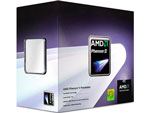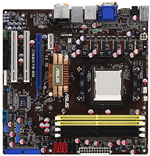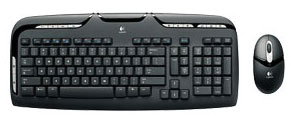AMD HTPC
Everyone asks for HTPC component recommendations, and then when we publish them readers can't wait to throw rocks at our recommendations. Perhaps this is because the HTPC, more than any other computer class, is a very personal machine. It needs to meet the specific needs and demands of the end users, who vary widely in what they plan to do with their new HTPC. So let's first talk about our concept in these two HTPC configurations.
We are assuming the user already has the HDTV (likely) or display he plans to feed, along with a sound system for that HDTV. The motherboards we recommend can reasonably feed audio signals for your Blu-ray movies, but they are not integrated audio amplifiers. Since most end-users are on cable or satellite for TV, we will make no recommendations at all for a TV tuner. Of the many possible uses of an HTPC the great majority of end-users store, play, and stream movies with their HTPC computers. That is mostly what their HTPC systems are used for and that is where we have concentrated our recommendations. In general the processing power in both systems has increased since our December 2009 guide, but costs have gone down a bit.
| AMD HTPC System | ||
| Hardware | Component | Price |
| Processor | MD Phenom II X3 710 (2.6GHzx3, 3x512KB L2, 6MB L3 Cache) |
$119 |
| Cooling | CPU Retail HSF | $- |
| Video | On-Board | $- |
| Motherboard | ASUS M3N78-EM | $90 |
| Memory | 4GB DDR2-800 - GSkill F2-6400CL5D-4GBPQ | $37 |
| Hard Drive | Western Digital Caviar Green WD10EACS 1TB SATA 3.0Gb/s Hard Drive - OEM | $105 |
| Optical Drive | LG BD/HD DVD / 16x DVD+/- RW GGC-H20L - Retail | $110 |
| Audio | On-Board | $- |
| Case | SILVERSTONE Black Aluminum/Steel LC13B-E ATX HTPC Case (After $15 Rebate) | $100 |
| Power Supply | PC Power & Cooling Silencer PPCS500 500W ATX12V / EPS12V SLI Ready CrossFire Ready 80 PLUS Certified Active PFC Power Supply - Retail (after $25 Rebate) | $50 |
| Base System Total | $611 | |
| Keyboard and Mouse | Logitech Cordless Desktop EX110 Black USB RF Wireless Keyboard & Optical Mouse | $30 |
| Operating System | Microsoft Vista Home Premium OEM | $99 |
| Complete System Bottom Line | $740 | |
 |
The CPU chosen for the AMD HTPC computer is the new triple core Phenom II X3 710 with 6MB of L3 cache. You get the expanded processing power of the Phenom II, which is always useful in an HTPC, at the same price as the older Phenom CPU chosen in the December guide. The three CPU cores each run at 2.6GHz, each with a 512KB cache, and a shared 6MB L3 cache - the same L3 cache sized shared on Phenom II quad-core processors. We hesitate to call a Phenom II X3 CPU a low-end chip, but this is certainly the most reasonable Phenom II you can buy. It has plenty of power, however, to drive your AMD HTPC to most anywhere you choose to go.
With DDR2-800 so reasonable these days we equipped the HTPC with 4GB of G.Skill memory. We aren't really interested in overclocking this HTPC (though it's technically still possible), and spending additional money on even higher performance RAM just doesn't make sense. 4GB of memory, however, does make perfect sense in an HTPC box.
 |
The $90 ASUS M3N78-EM is based on the NVIDIA GeForce 8300 chipset. The board features one PCI-E x16 slot, one PCI-E x1 slot, two PCI slots, 8GB memory support, NVIDIA Gigabit LAN, 7.1 HD audio, 12 USB ports, five 3Gb/s SATA ports with RAID support, IEEE 1394a, one eSATA port, HDMI/DVI/VGA output, and full support for the Phenom 140W processors. This board offers overclocking capabilities along with being a top notch HTPC capable board. We highly recommend the GF8200/8300 series for the HTPC market due to hardware accelerated Blu-ray/H.264 playback, multi-channel LPCM output, and very good application performance.
 |
As we discussed in the HTPC introduction, we did not include a TV tuner in the configuration since most end-users are now using their cable and satellite feeds. Few users, therefore, have any real need for a TV tuner card. There's something else to consider in this, and that is the US government mandated deadline to end analog broadcasts (which is now in June), so older/cheaper analog tuner cards are now useless unless you have an analog Cable/Satellite signal. If you truly need a Digital TV tuner, one option that is pretty unique on the TV tuner side is the HD HomeRun from Silicondust USA. This is a dual HDTV tuner/recorder that functions over a network and provides ATSC/QAM support. The price of $169 is more than many other options, but this is arguably a more flexible overall solution - particularly with the mandated move to digital and away from analog.
What's the point of having an HTPC if you don't have a lot of storage space? To that end, we selected a newly affordable 1TB (1000GB) Western Digital Caviar Green WD10EACS SATA hard drive at just $105. The WD Green is a variable speed energy saving design that we found to be among the quietest drives we have ever evaluated. For an HTPC, quiet operation is paramount and this WD Green will not disappoint. The WD Green is a bit slower than true 7200RPM 1TB drives, but the real performance difference is very minor. Another excellent HD option is the Seagate Barracuda 7200.11 ST31000333AS 7200RPM 1TB at $110. Performance of this 1TB drive has been exemplary in early testing at AnandTech, and the drive has proved to be reasonably quiet. Seagate also makes a super-reliable 1TB drive optimized for video storage and retrieval called the Seagate SV35.3 ST31000340SV 1TB at $150. This "video" Seagate features 24x7 reliability with > 1 million hours MTBF and improved read/write reliability. For those willing to pay the small premium the "video" Seagate would be a good alternate choice.
 |
The optical drive is certainly an upgrade to the entry and budget systems since a reasonable HTPC requires Blu-ray playback capabilities. The LG Black 6X Blu-ray SATA fits the bill without breaking the bank. It provides 6X Blu-ray playback and the fastest recording and playback of DVD and CD media. The current price is around $110, but this drive sometimes goes on sale for $100 so look out for specials. There are also Blu-ray options under $100 from Lite-On and a 6X Blu-ray player at $105. We do not have much experience with this Lite-On drive, but Lite-On drives in the past have proved reliable. That would make the Lite-On Black 6X Blu-ray SATA a more reasonably priced alternative where every penny counts.
 |
Our choice for an HTPC case is the audio component look in the Silverstone LC13B-E, which is an extremely flexible design with two silent fans and silent power when combined with the PC Power and Cooling 500W Silencer power supply. This solid Silverstone case can handle either ATX or Micro ATX motherboards, with space for four internal hard drives in addition to two 5.25" External bays and two 3.5" external bays. If your plans for your HTPC include lots of comportments and storage the Silverstone is an excellent choice. If you prefer a small cube case the Lian Li PC-V350B is a gem of a small black aluminum case. The Lian Li is our choice for the Intel HTPC system on the next page, and you can find more information on that case there.
 |
Since most will place their HTPC near their HDTV or big screen monitor, a wired keyboard and mouse are not really very useful in most setups. Control is more often from across the room, so a wireless RF Logitech keyboard and mouse were selected. At just $25 for the pair, the Logitech Cordless Desktop EX110 wireless keyboard and mouse is a great value. This is also the HTPC preferred RF wireless set, which does not require "line of sight" that is needed for IR wireless.
The final price of the AMD HTPC comes to just $740. That has to be considered a bargain considering the triple core Phenom II CPU, 4GB of memory, and 1TB hard drive all housed in a quiet Silverstone HTPC case with a PC Power and Cooling Silencer 500W PSU. You can certainly spend even less on a basic HTPC box, but we doubt you can build a more powerful or quiet system for the same money.










66 Comments
View All Comments
7Enigma - Monday, March 16, 2009 - link
I think you're splitting hairs. Both of their Budget systems are fine for gaming if you add in a discrete graphics card. And in both system descriptions they mention adding a graphics card. Reading between the lines means add a graphics card and you have a gaming rig.Pretty simple.
frozentundra123456 - Monday, March 16, 2009 - link
With prices so low, I would say to include a mid-range graphics card such as the HD4670 with any system. The 4670 uses very little power and will improve video and allow decent basic gaming for less than 100.00 additional cost. It seems it is worth this even for the lowest end system which would still cost about 500.00 with monitor and OS and no graphics card.Hrel - Monday, March 16, 2009 - link
You can get a 640GB Hard Drive from Seagate with 32MB of cache, a 7200rpm speed and SATA connection for $60. So, 500GB or 640GB for $60? Hm, tough choice... sarcasm.MrSpadge - Saturday, March 21, 2009 - link
I agree, the systems should have faster HDDs! I'd choose the WD 640 GB 7200 rpm over the Seagate for speed. The WD green power has amazingly tuned firmware and it's faster than many elder 7200 rpm dirves, but it's not a magician and is held back by its 5400 rpm.Just think for a moment what limits the performance of a PC under "normal" use. What happens when you get to an elder machine, even with a healthy windows? Well, if you tell it to do anything you'll be greated by a constant "crrrrrrrr" from the HDD. Not the CPU or GPU is limiting, it's the HDD! That's why going with a 5400 rpm drive is almost silly.. you give up 15 - 20% speed and gain ~3W in power consumption. For the HTPC it's alright though, as it doesn't keep you from working if you have to wait for the HDD.
Hrel - Monday, March 16, 2009 - link
sorry, my bad, that drive is $70 now; it was $60 dollars like week ago though.AntiM - Monday, March 16, 2009 - link
I would say that 85% or more people could get by just fine with these machines. They are perfect for simple office machines. You could probably go even cheaper on the AMD system with an Athlon 64 X2 5600+ and 2 GB or RAM and still have plenty of horsepower for an office machine.Wesley Fink - Monday, March 16, 2009 - link
You can definitely go lower on the AMD CPU, but do you really think anyone would want to pay $67 for a 5600+ or 5600 Brisbane, when they can get a 7750 Kuma Black Edition for $7 LESS at $60. Pricing in entry space can be very strange.I also think dropping RAM from 4GB to 2GB is not very cost effective when you save just $17 by halving the RAM. If every penny counts I guess that that $17 could be important.
AgeOfPanic - Monday, March 16, 2009 - link
With the decoding capabilities of the current IGP chipsets why choose a Phenom processor with higher TDP over a Athlon X2 5050E?Penti - Tuesday, March 17, 2009 - link
A lot of people use homebrew (unlicensed) codecs for warez and their video watching. Those are usually software only or have a limited support for DXVA. Like many alternative media-portal/center software. If you don't want that flexibility there are other devices that even play warez that might fit your bill. But it's only commercial codecs that has decent hardware acceleration. You might also need the power for recording and encoding.7Enigma - Monday, March 16, 2009 - link
I think the answer is, "because we can". Honestly for a true HTPC the last article was fine, and nothing has really changed since then IMO. Yes you can for the same money get a more powerful system or even slightly cheaper, but the HTPC's job is not to be more and more powerful for the same/less money, it's to be cool and quiet while allowing for 1080p and all the resolutions below.Where the latest HTPC systems are beneficial is if you are using the HTPC box to rip or encode to different compressed formats while simultaneously watching something else, and/or recording multiple signals. Then it will be beneficial to have the Phenom II 3-core over a lowly X2.